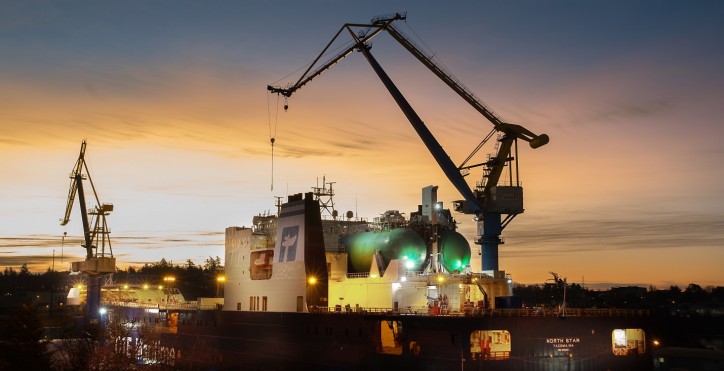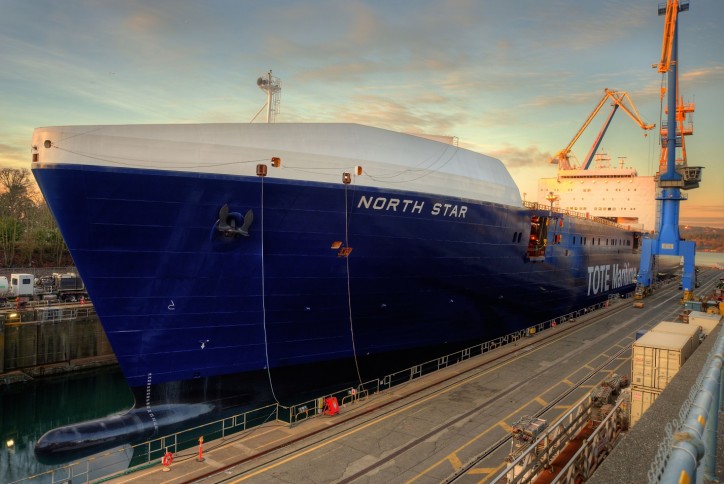Seaspan Shipyards (Seaspan) demonstrates its capabilities with liquefied natural gas (LNG) vessel engine conversions in the wake of a major project milestone.
Victoria Shipyards (VSL) was selected by TOTE Maritime Alaska to carry out the yard production work and docking necessary for the conversion of their two TOTE Orca class vessels to dual-fuel systems, a process which is being carried out in four phases and will enable the two ships to use LNG as fuel.

The ‘North Star’, the first of the two 839-foot-long roll-on, roll-off cargo ships which carry cargo between Anchorage, Alaska, and Tacoma, Washington, arrived at VSL in December, 2017 kicking off the process of converting the diesel engines to dual-fuel systems.
The first of the two vessels slated for conversion - the ‘North Star,’ has now completed a 60-day visit to the shipyard, which along with ‘Midnight Sun’ will provide employment for 300 to 400 people working six days a week. Following her recent stay, she returned to Alaska, marking the first voyage outfitted with two new LNG tanks.
“Seaspan Shipyards is proud to have conducted this work for TOTE Maritime Alaska as part of its efforts to convert its fleet to LNG-fuelled vessels,” noted Brian Carter, President & CEO of Seaspan Shipyards. “With the completion of this first phase of work, our workforce has demonstrated that it is fully capable of handling these complex conversions and we look forward to future work on similar projects.”

Over the next four years, three more conversion periods will be required to finalize the transition of TOTE Maritime Alaska’s vessels to LNG. Each of these conversion periods will take place in the winter to minimize the impact to customers and consumers alike. The conversion of both ships is scheduled to be complete in Q1 of 2021.
The completion of the first phase of this project at Victoria Shipyards is a clear indicator that Seaspan’s workforce has the necessary skills to successfully complete LNG conversation projects, in addition to a broad range of vessel repairs.
“Phase one of the first major LNG conversion in North America on a full-sized vessel has now been successfully completed,” said Joe O’Rourke, Vice President & General Manager of VSL. “We plan to continue to build our reputation as an industry expert for all LNG related work on the West Coast. And we express our thanks to TOTE and their entire team in placing their trust with VSL on this first in kind project.”
One of the key components behind TOTE’s decision to retrofit the vessels to LNG was to reduce the most harmful emissions that result from burning diesel. Retro-fitted engines will meet and exceed all new emission standards and new components will extend the vessels’ working lives.
“Victoria Shipyards has demonstrated that they have the technical expertise and skilled work force to guide TOTE Maritime Alaska’s Orca class vessels through the conversion process,” noted Phil Morrell, Vice President Marine Operations. “They are the right partner for TOTE in this important environmental effort.”
TOTE Maritime was the first maritime shipping company in the world to announce its intention to convert their fleet, enabling the engines to use both LNG and diesel.
“Working on projects that benefit the environment is well-aligned with our corporate values and LNG conversions represent an important opportunity for our company to contribute towards environmental sustainability in the marine shipping industry,” added Brian Carter.
Seaspan is committed to care for the environment and adheres to rigorous environmental standards and participates in certification programs like Green Marine.
Source: Seaspan Shipyard